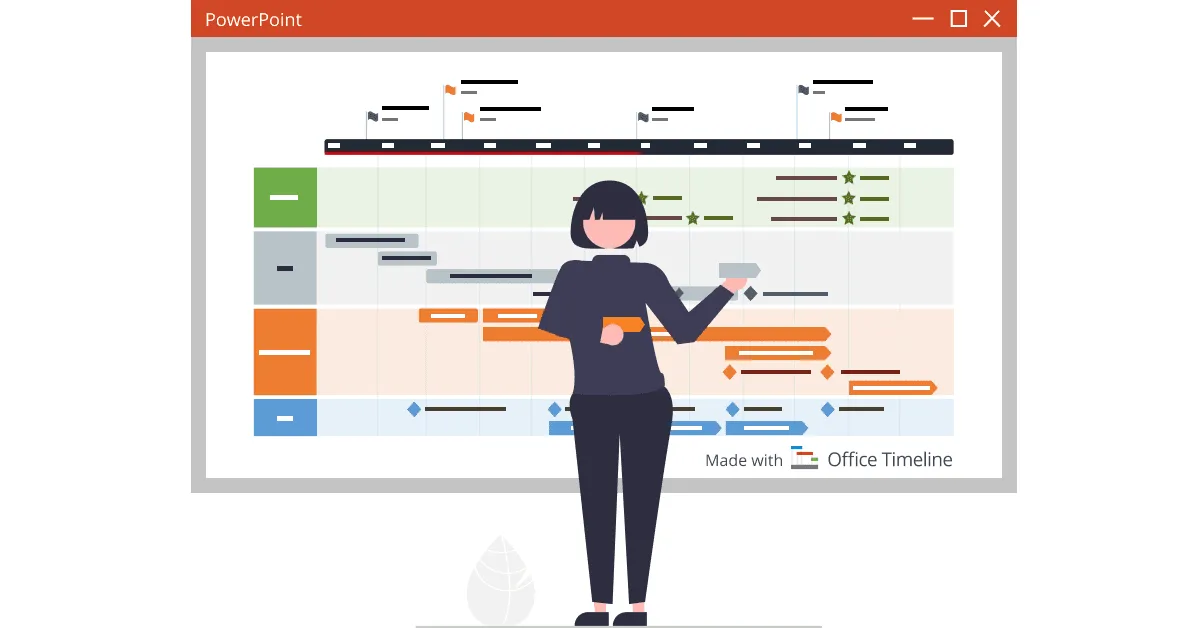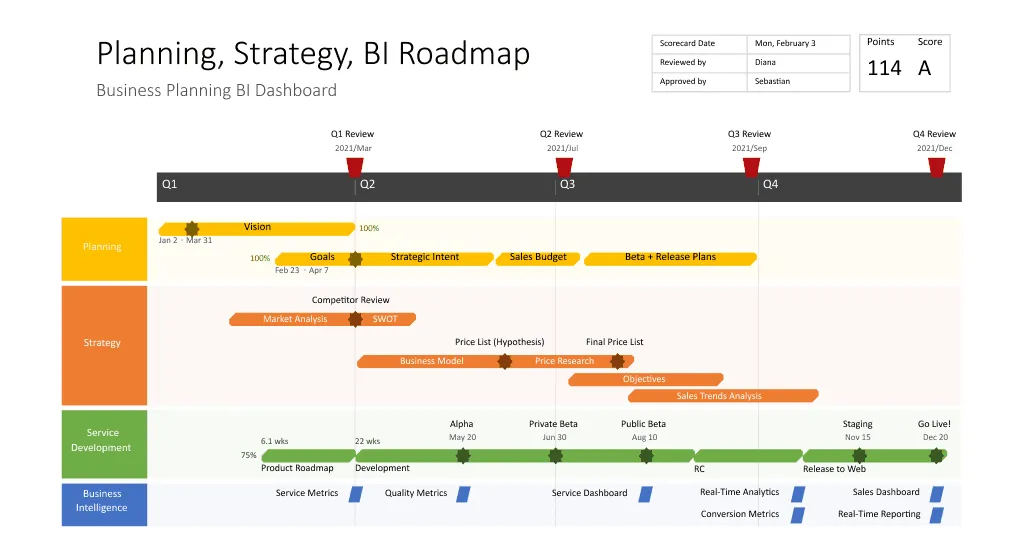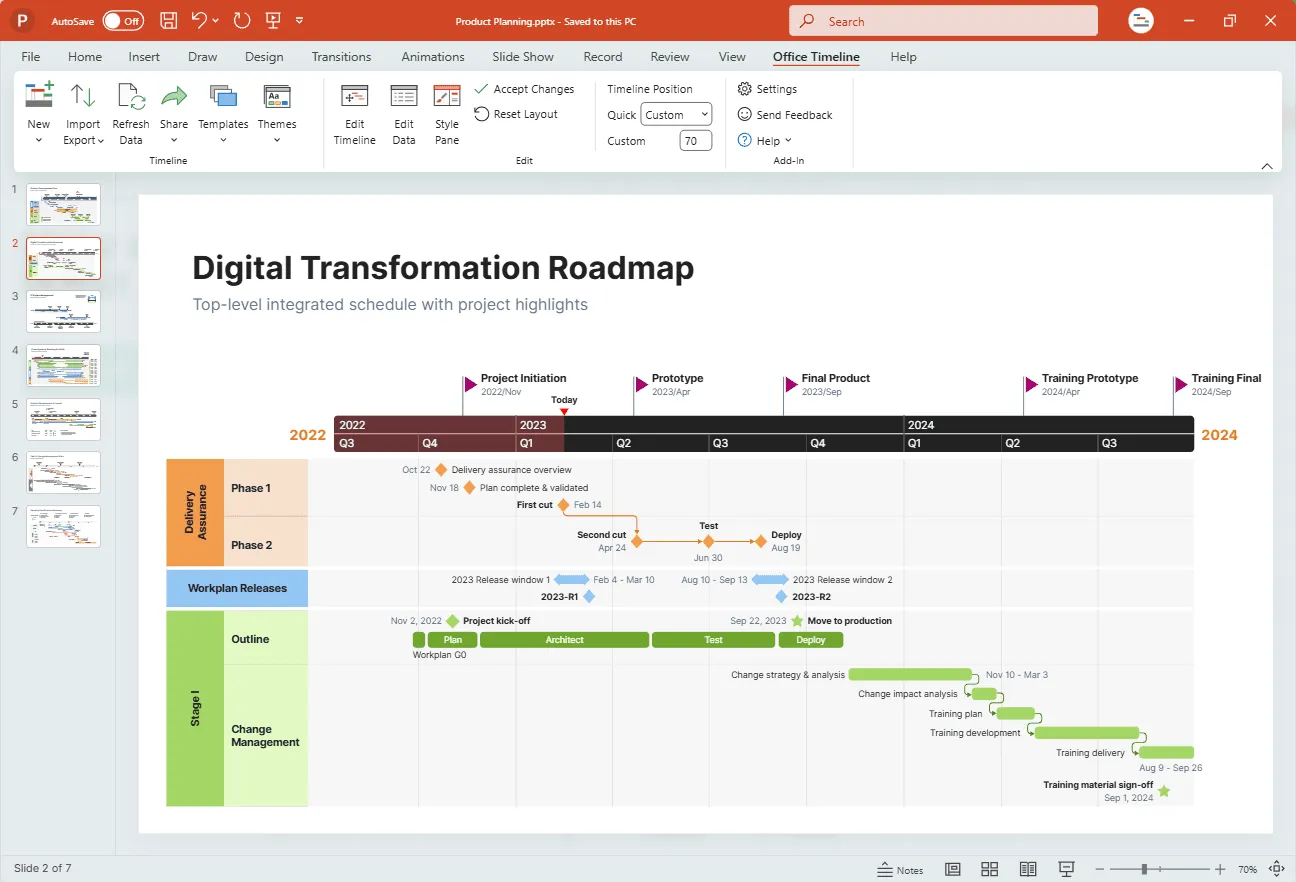Getting started with roadmaps
Strategic planning is a cornerstone of managing projects or initiatives of any kind, and it’s especially critical for turning a business vision into reality. A simple visual like a roadmap offers a clear overview of strategic tasks and milestones, helping you define a long-term plan to achieve your goals.
To make things easier, we’ve pulled together resources for creating and managing your project or product roadmap. Here, you’ll find everything you need – from a clear definition of what a roadmap is, to practical examples, easy-to-use tools, and free roadmap templates so you don’t have to start from scratch. Let’s dive in!
What is a roadmap in Project Management?
Simply put, a roadmap is a strategic planning technique that maps a project’s goals and key deliverables (tasks, milestones) onto a timeline, all brought together in a single visual. Unlike a detailed project plan, a roadmap provides a high-level, easy-to-grasp picture that highlights the what and why of an initiative rather than every operational detail.
Characteristics of a roadmap
A roadmap defines the overall goal and the major steps required to achieve it. It clarifies the why behind the desired outcome and outlines the path for reaching it across different strategic initiatives.
To better understand its role, let’s look at what a roadmap is – and what it isn’t.
What a roadmap is | What a roadmap is not |
|---|---|
|
|
|
|
|
|
Why do you need a roadmap?
A well-crafted roadmap helps businesses and project or product managers decide wisely where to commit resources. By aligning each work item to overarching objectives, a roadmap ensures time and effort are invested effectively and provides a strong foundation in terms of:
- Clarity – by answering “what are we working towards and why?”, a roadmap defines strategic goals and shows how work connects to the broader strategy.
- Communication – by sharing an initiative’s strategy, a roadmap highlights direction, visualizes timing, and supports transparent conversations about challenges with key stakeholders.
- Coordination – in large or complex projects, a roadmap improves collaboration across teams, helps track dependencies, and reveals bottlenecks.
- Accountability – by setting out what needs to be delivered and when, a roadmap makes it easier for everyone to follow through on commitments.
- Alignment – by clearly stating vision and objectives, a roadmap brings teams, portfolios, and business units onto the same page.
- Impact – by tying investments to high-level goals, a roadmap illustrates the value and outcomes of a team’s progress.
- Prioritization – by focusing on what matters most, a roadmap enables managers to make trade-offs and prioritize initiatives that deliver the greatest benefit.
Showing the why behind planned initiatives, a roadmap benefits any type of business because it:
- clarifies business strategy,
- communicates company-wide initiatives to internal teams,
- links departmental goals to organizational objectives,
- shares plans with external audiences such as partners or advisory boards,
- tracks performance at an organizational level.
Serving as a reference point for everything a team focuses on, a visual roadmap is especially valuable in high-level meetings with clients and executives because it helps you:
- illustrate how business strategy connects to company goals,
- translate product goals and initiatives into features and requirements,
- communicate with leadership, cross-functional teammates, and customers,
- prioritize new functionalities and enhancements,
- report progress and status as the project advances.
Roadmap examples
The structure of a roadmap can vary from project to project, but there are several key elements every roadmap should include:
- Goals and initiatives – define the value your product or project delivers and how it supports business objectives.
- Releases and milestones – indicate when major work will start and be completed.
- Features – show the prioritized efforts based on their overall value and impact.
- Dependencies – highlight interrelated work that could influence delivery.
To recap: regardless of the initiative, a roadmap should always connect your strategy (the why), the actions required to achieve your goals (the what), and the timeline for execution (the when).
Take a look at the sample roadmap below to see how these elements come together in practice.
Roadmaps offer a flexible way to present strategic information, so there’s no single industry standard to follow. Each initiative – whether in Marketing, HR, Operations, or IT – can take a different approach. Still, most professionals rely on a roadmap creator to build one of the popular roadmap types shown below.
To save you time, we’ve prepared free downloadable examples (built in PowerPoint with the Office Timeline add-in) so you can get started right away.
You can use these roadmap examples in many ways to support smarter decisions for your strategic initiatives. Visit the roadmap templates page to find the format that suits you best, then download and customize it to fit your needs.
How to create a roadmap
Here are the five main steps to building an effective roadmap:
- Define your strategy – outline the overall vision, goals, and initiatives. In-depth research into buyer personas, product positioning, and competitive analysis provides the context and foundation for your strategy.
- Review and assess potential features – use a scoring system to evaluate features and identify which ones deliver the greatest value to your initiative.
- Prioritize and determine requirements – break down the activities that best support your strategy into smaller, actionable units of work.
- Organize work into phases – group your prioritized features or efforts into releases or stages and define their duration.
- Choose your roadmap view – decide how much detail to include and how best to illustrate your plan over a given timeframe. For example, you may want to highlight specific features or cross-functional dependencies that could affect delivery.
Once you’ve completed these steps, you can move on to creating your visual – either by using a roadmap template or a dedicated roadmap tool.
For hands-on guidance, explore our step-by-step tutorials to learn how to make a roadmap using different office tools.
Roadmap templates
What is a roadmap template?
A roadmap template is a pre-built roadmap sample you can easily customize with your own data. It provides a ready-made framework for specific cases, helping you save time and effort when creating a roadmap from scratch.
Why use a roadmap template?
Roadmap templates make it simple to capture and communicate your product or project plans. With a professional structure already in place, you can quickly build a timeline that clearly illustrates your goals, initiatives, supporting efforts, and due dates. Templates are easy to update as plans evolve and can be reused for future initiatives, eliminating the need to reinvent the wheel.
Start building your first roadmap with our free downloadable roadmap templates, which you can tailor to your specific requirements. Some are designed to share high-level business goals, while others are better suited for showing detailed initiative plans. You’ll also find examples tailored to particular industries or organizational needs.
Simply download your preferred template, add your project or product data, and present a polished, ready-to-share roadmap.
Ready-made roadmap templates
A variety of professional, stand-alone templates that you can instantly customize into your own beautiful roadmap.
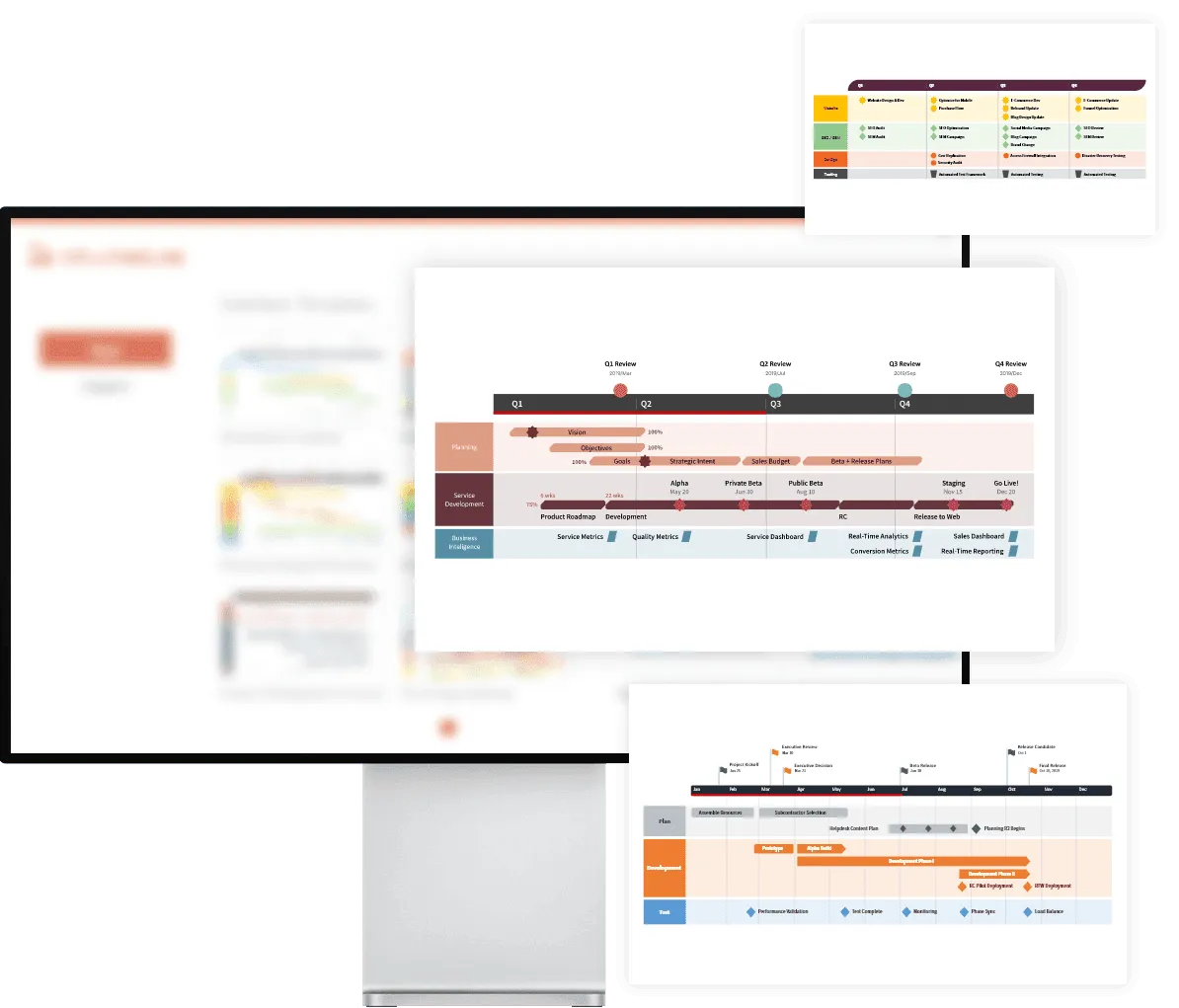
Roadmap tools
Whether you’re starting a business, launching a new product, or managing a cross-functional project, a roadmap helps you visualize your strategic plan and turn it into reality. It reflects the output of your planning process and serves as a key tool for communicating initiatives to stakeholders in a clear, compelling way.
That’s why it’s important to use purpose-built roadmap software that enables you to easily create and customize high-level visuals, then share them seamlessly with executives, team members, clients, and other stakeholders.
One such dedicated roadmap maker is Office Timeline, a PowerPoint add-in designed for professionals. This intuitive tool automatically generates clear, stylish roadmaps as PowerPoint slides that can be updated in seconds and shared or presented in meetings with ease.
Roadmap maker for PowerPoint
See how easily you can build, update, and share professional roadmaps in PowerPoint with Office Timeline.
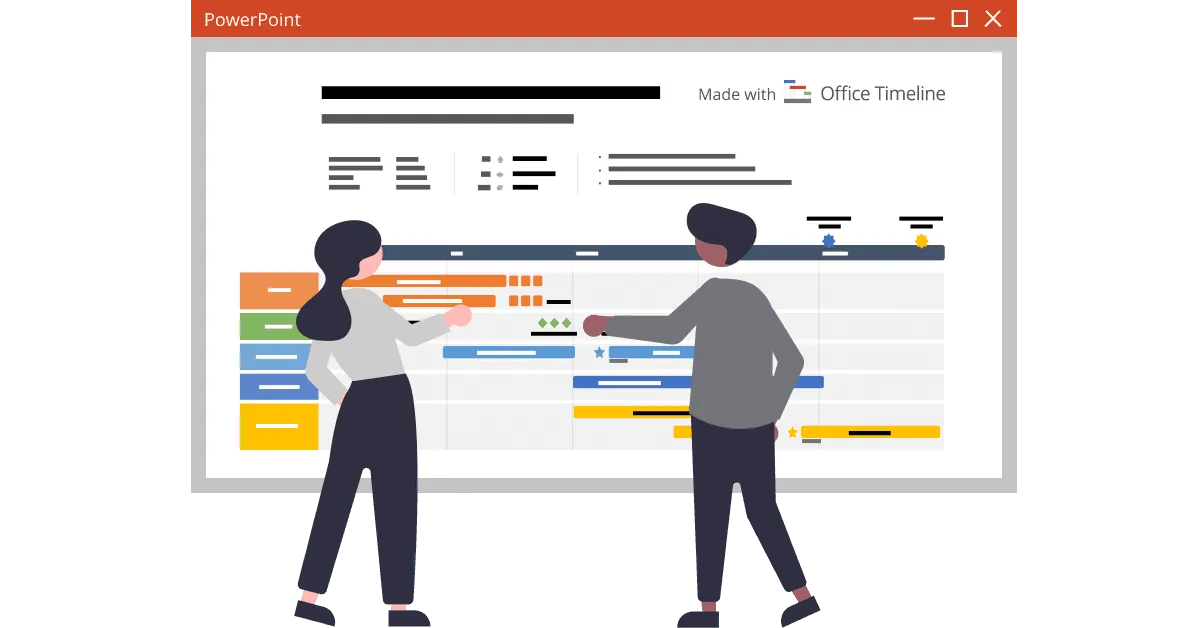
How to choose a roadmap tool
With so much riding on your roadmap, it’s no surprise that choosing the right roadmap tool can feel challenging. To help you decide, here are the top five factors to consider when reviewing the many roadmap tools available today:
- Time-saving. Does the roadmap app make it quick and easy to create and update your visual? You may have just minutes to prepare for a critical client or leadership meeting. Look for an agile roadmap maker that automates work with just a few clicks.
- Customization. Every project is different. Should they all use the same colors and shapes? Definitely not. Choose agile roadmap software that lets you customize every detail – colors, shapes, fonts, date formats – so your roadmap reflects your unique project style.
- User-friendly. Collaboration is the norm, and you’re constantly working with clients and colleagues. You’ll need a roadmap tool that adapts to the way your teams work, producing visuals that are easy for anyone to view, edit, download, or share using familiar office tools.
- Integrations. If you rely on popular project tools like MS Project or Wrike, choose a roadmap creator that integrates seamlessly with them. This way, you can build roadmaps directly from your project data. A refresh function to automatically update your roadmap when your documentation changes is a major plus.
- Visuals. Clear, simple visuals are essential. Select software that produces roadmaps with the right balance of professionalism and polish – helping you stand out and make a lasting impression on managers, clients, and stakeholders.
Need more help choosing the right roadmap tool? Explore our dedicated section on roadmap tools.
Best practices for roadmaps
To serve their purpose, roadmaps should be:
- accurate,
- actionable,
- up to date,
- relevant and easy to understand for the intended audience,
- visually compelling.
Below are practical guidelines for updating, sharing, and presenting roadmaps that convey information quickly, clearly, and with impact.
Tips on how to share or present a roadmap
For product or project managers, presenting a roadmap effectively starts with understanding the audience – who they are, what they need to know, and why. This allows you to adjust the level of detail and focus so the right message reaches the right people in a visually engaging way.
Key elements of an impactful roadmap presentation:
- Audience-awareness – adapt your roadmap to your audience and desired outcome. Executives and advisory boards expect a focus on high-level initiatives and timelines, while engineering or IT teams need detail on features, requirements, and release dates. For customers, stick to a general overview of features and approximate timing.
- Agenda – once you’ve identified your audience, set an agenda that outlines the core aspects you’ll cover. This sets expectations and keeps discussions focused.
- Purpose – every presentation should have a goal. To ensure your roadmap resonates, ask: “Why is this information being shared with this audience?”, “What should they take away?”, and “What feedback would be most useful?”
- Vision – place your roadmap in the broader context by including business model, goals, personas, and competitors. This shows how your plan fits into the overall product or company strategy.
- Feedback – treat roadmap presentations as an opportunity to gather insights from internal and external stakeholders. Allocate time for questions and comments.
- Shareability – a roadmap is more than a one-off presentation; it can serve as an ongoing reference point for decisions. Ensure appropriate access and clarity on how often it will be updated.
Tips on how to use or update a roadmap
As a high-level plan that maps out the work needed to achieve a goal along with its schedule, a roadmap should use clear visual elements such as:
- Timeframe – use a timeline that reflects the actual duration of your initiative. If a project spans three months, a one-year view will dilute clarity. Timelines are typically placed at the top for quick comprehension.
- Hierarchy – for complex initiatives, organize and break down work into smaller units. Display them by start and end dates, status, or priority, or group them by categories for clarity.
- Progress – show the status of tasks and overall advancement using progress bars, color codes, checkmarks, or percentage indicators.
- Colors – apply different colors to differentiate ownership or teams, making it easier to distinguish phases or responsibilities.
- Symbols – add subtle cues with shapes, arrows, or connectors. Diamonds can mark milestones, while arrows highlight dependencies. Whatever symbols you use, keep them consistent so your audience can easily interpret them.
Since plans evolve and priorities shift, your roadmap must remain flexible and easy to update – not just quarterly or by release cycle. Choose an interactive dedicated tool that allows you to:
- quickly reflect ongoing changes in your roadmap visuals,
- integrate seamlessly with other systems in your organization,
- share updates easily across the company,
- customize and style details to create clear, distinctive visuals.
Frequently asked questions about roadmaps
Here are the answers to the most frequently asked question about roadmaps.
A roadmap is a high-level visual plan that maps out the lifecycle of a business initiative. It shows the end goal, the major steps required, and the milestones to achieve along the way. Roadmaps are primarily used for strategic planning in projects and for guiding product development, giving stakeholders a clear picture of direction and progress.
A project roadmap is a strategic overview of a large-scale operation or initiative. It outlines the scope, key deliverables, high-level schedule, milestones, risks, and potential challenges. Unlike a detailed project timeline, which focuses on day-to-day activities, a project roadmap highlights the big picture. Its purpose is to keep work aligned with the original deadlines and adjust deliverables when needed to stay on track.
A well-structured project roadmap typically covers:
- Short- and long-term objectives – the vision and the goals to achieve.
- Tasks, milestones, and dependencies – the building blocks of progress.
- Resources and allocation strategy – who is involved and how capacity is used.
- Timeline of the project lifecycle – when work starts, ends, and what happens in between.
- Risks and challenges – potential blockers and how they may impact delivery.
Together, these elements create a comprehensive, high-level plan that is easy to understand and share.
Roadmaps provide a common framework for collaboration and decision-making. They allow stakeholders to:
- Evaluate the competitiveness and feasibility of a strategy.
- Spot issues and gaps before they escalate.
- Prioritize resources effectively.
- Set realistic targets based on market and project data.
Without a roadmap, initiatives lack direction and clarity, making it harder to coordinate teams, allocate resources, and reduce the risk of project failure.
A backlog is an execution-oriented list of tasks, stories, or ideas, usually ranked by priority. It tells teams what to do next. A roadmap, on the other hand, provides the strategic overview – it connects those tasks to long-term goals, showing why they matter and how they contribute to the bigger picture.
A project tracker is a detailed operational tool: it records every task, assignment, meeting, and deadline needed to deliver a project. A roadmap takes a higher-level view. Instead of cataloging every action item, it highlights the major phases, milestones, and objectives so stakeholders can understand the direction and progress at a glance.
A feature list is just that – a collection of product functions without context. It shows what exists or what might be built. A roadmap, in contrast, is a strategic narrative: it explains why certain features are prioritized, how they interconnect, and how they serve business goals.
The fastest way to build a professional roadmap is by using a dedicated roadmap maker such as Office Timeline. This type of tool saves hours of manual design work and lets you focus on strategy and project specifics. Here are the basic steps to create a roadmap:
- Define your timeline and project phases.
- List all tasks, milestones, and dependencies.
- Break down workstreams into logical groups (e.g., swimlanes).
- Continuously update the roadmap as new developments arise.

